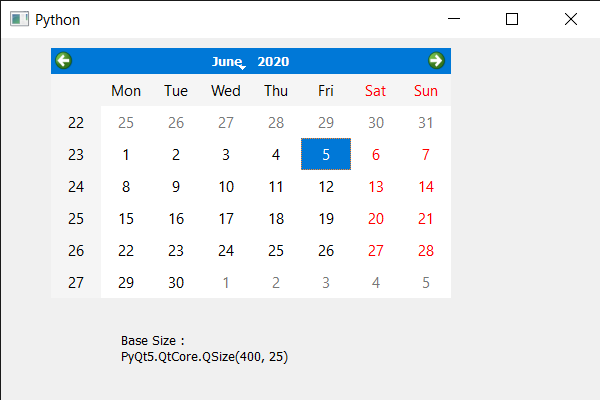En este artículo veremos cómo podemos acceder al valor del tamaño base del QCalendarWidget. Por defecto, el tamaño base tiene un valor cero tanto para el ancho como para la altura, el tamaño base se usa para calcular un tamaño de calendario adecuado si el calendario define sizeIncrement, es decir, su tamaño cambia cuando cambia el tamaño de la ventana. El tamaño base es el tamaño inicial del calendario. El tamaño base se puede configurar en el calendario con la ayuda del método setBaseSize.
Para hacer esto, usaremos el método baseSize con el objeto QCalendarWidget.
Sintaxis : calendar.baseSize()
Argumento : No toma ningún argumento
Devolución : Devuelve el objeto QSize
A continuación se muestra la implementación:
Python3
# importing libraries
from PyQt5.QtWidgets import *
from PyQt5 import QtCore, QtGui
from PyQt5.QtGui import *
from PyQt5.QtCore import *
import sys
class Window(QMainWindow):
def __init__(self):
super().__init__()
# setting title
self.setWindowTitle("Python ")
# setting geometry
self.setGeometry(100, 100, 600, 400)
# calling method
self.UiComponents()
# showing all the widgets
self.show()
# method for components
def UiComponents(self):
# creating a QCalendarWidget object
self.calendar = QCalendarWidget(self)
# setting geometry to the calendar
self.calendar.setGeometry(50, 10, 400, 250)
# setting base size
self.calendar.setBaseSize(400, 25)
# creating a label
label = QLabel(self)
# setting geometry
label.setGeometry(120, 280, 200, 60)
# making it multi line
label.setWordWrap(True)
# getting the base size
value = self.calendar.baseSize()
# setting text to the label
label.setText("Base Size : " + str(value))
# create pyqt5 app
App = QApplication(sys.argv)
# create the instance of our Window
window = Window()
# start the app
sys.exit(App.exec())
Producción :

Publicación traducida automáticamente
Artículo escrito por rakshitarora y traducido por Barcelona Geeks. The original can be accessed here. Licence: CCBY-SA